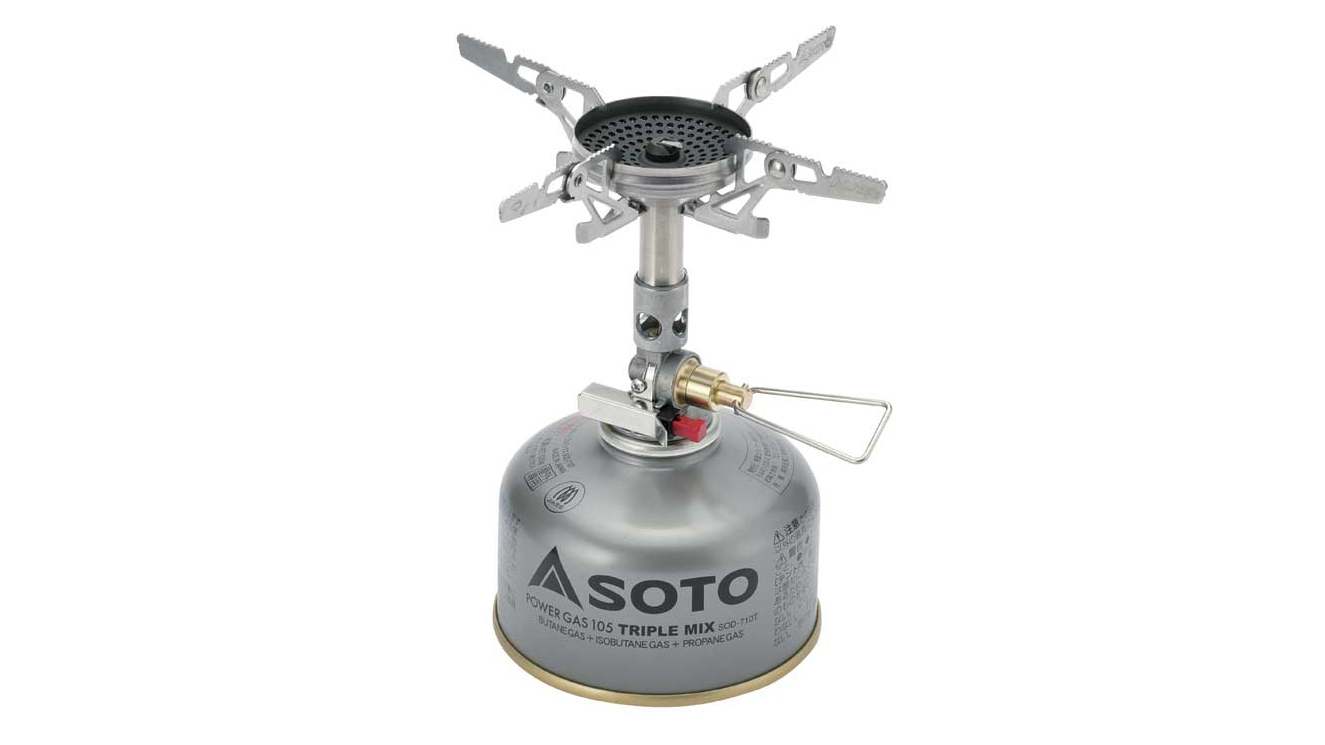Advnture Verdict
We reckon the SOTO Windmaster is just about the most effective screw-in, canister-top stove around, making it a top pick for lightweight wild campers or committed backpackers embarking on extended thru-hikes.
Pros
- +
Very lightweight
- +
Tiny packed size
- +
Good wind resistance
- +
Built-in regulator
- +
Integrated ignition
Cons
- -
No hard case for storage
- -
Separate four-prong pot support seems delicate and would be easy to lose
You can trust Advnture
First impressions
Despite its diminutive size and weight, the SOTO Windmaster is a pretty powerful stove, with a rated output of 3,260W. Yet it tips the scales at a mere 100g and has very compact dimensions when packed away. These competitive specs ought to make the Windmaster an extremely attractive option for lightweight adventurers who still want the convenience of cooking on gas.
Multiple features are packed into this little burner too, which only make it even more impressive. First up, it has a built-in micro regulator. This gives you more consistent power output and better fuel efficiency, especially in colder weather or when your gas canister is running on empty. It’s a feature that many cheaper and superficially similar screw-in stoves lack, but one that can make a big difference to your fuel consumption and therefore your pack weight.
- Cook outdoors under any conditions with out best camping stoves
- The best trail mix will keep your energy levels up
- Need to stay fed outdoors? Check out the best backpacking meals
There’s also an integrated ignition, which saves you from having to carry lighters, matches or a fire steel, again a potential weight saver. And though we wouldn’t normally trust to relying on a single method of lighting your stove, just in case it fails, the Windmaster’s ignition system is more robust than most.
The principal parts are neatly enclosed within the burner stem, while the sparker at the burner head is a chunky strip of metal rather than a flimsy piece of wire. This makes it less liable to become brittle and snap (a shortcoming of many other stoves, notably the earlier versions of the Jetboil range).
• Power: 3,260W / 11,123 BTU/hr
• Packed weight: 100g / 3.5oz
• Minimum weight: 87g / 3oz
• Burner diameter 4.5cm / 1.8in
• Pot support diameter: 14.2cm / 5.6in
• Assembled height (with 227g gas canister): 18cm / 7in
• Packed size (HxWxD) 8.8 x 9 x 4.7cm / 3.5 x 3.5 x 1.85in
• Boil time (500ml of water at sea level in zero wind, air temp 16°C / 61°F, starting water temp 11°C/52°F): 2 min 14 seconds
In the field
The SOTO Windmaster is easy to set up. There are no intricate bits here – just unfold the control handle and snap the spring-loaded pot support to the rim of the burner head. Once screwed on to a standard threaded canister, the stove roars satisfyingly into life with a simple click of the ignition. The long control handle offers pretty precise simmer control, and keeps your hand safely away from the flame, preventing burnt knuckles.
It’s well named too, because for a canister-top stove – not traditionally a very windproof design – it is able to stay alight in breezy and even gusty conditions, which in our experience invariably blow out most similar stoves. This solid performance comes down to the broad, concave burner head, which also has a small but well-designed protective lip.
The removable four-pronged pot support has a low profile, which also helps ward off gusts by placing your pot close to the flame. In addition, it provides a stable base for all but the biggest backpacking cookware, while the relatively wide burner head distributes heat evenly. Indeed, after knocking up a quick and dirty packet of Kraft mac and cheese, we noted far less burnt-on mess to clean up afterwards.
Like all canister-top designs, with the SOTO Windmaster your cooking pot does sit a fair way off the ground when it’s all set up. This does affect stability slightly, though a gas canister stand helps here. Still, it doesn’t feel worryingly precarious, thanks in large part to the toothed arms of the pot support.
These tend to keep most pots firmly in place. We did have a slight reservation with other design elements of the pot support though. It’s a cleverly engineered accessory, but the fact it isn’t physically attached to the burner could make it easy to lose, especially in long grass. Its folding prongs at the ends of the four arms also seem fairly delicate.
A final point to note is that although the stove comes with a storage bag, there’s no protective hard case – something you get with rivals like the Snow Peak GigaPower stove and the MSR PocketRocket models. Of course, if you normally nest your stove inside your cookware, this won’t be an issue.
An outdoors writer and editor, Matt Jones has been testing kit in the field for nearly a decade. Having worked for both the Ramblers and the Scouts, he knows one or two things about walking and camping, and loves all things adventure, particularly long-distance backpacking, wild camping and climbing mountains – especially in Wales. He’s based in Snowdonia and last year thru-hiked the Cambrian Way, which runs for 298 miles from Cardiff to Conwy, with a total ascent of 73,700 feet – that’s nearly 2½ times the height of Everest. Follow Matt on Instagram and Twitter.


